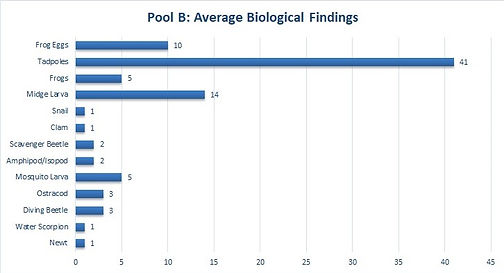Vernal Pool Data: 2017
The 2017 data was collected by Ridgefield 4th graders. Students studied two separate pools on the Woodcock grounds over the course of 18 visits, from March through May.
Students collected three data sets at each pool: Biological, Physical, and Chemical. Below is a summary of the data collected at each station for comparison over time.


Biological Data: What organisms are present in each pool? Samples were collected using dip nets. Students then identified, sorted, counted, and recorded the organisms found.
Chemical Data: The quality of water will affect the growth, development, and survival of all life in the vernal pool. Students measured the pH, temperature and dissolved oxygen.
pH: pH is a measure of the acidity in a substance. Fresh water is usually neutral (pH = 7). Vernal pools are typically more acidic (pH between 4-5) from the decomposition and break down of the leaves found at the bottom. Acid rain and other pollutants can also increase the acidity of pools which can cause deformities or death in amphibians.
Temperature: Amphibians are cold blooded and cannot regulate their body temperature. If there is a cold spell in the spring the adult frogs and egg masses can freeze. If the temperatures warm rapidly, the pools are at risk of drying before the tadpoles and salamander larva have fully grown into adults.
Dissolved Oxygen: All aquatic life in the pools need oxygen to survive. Dissolved Oxygen is the amount of free oxygen (O2) present in the water (not the O in H2O). Oxygen enters the pool from the atmosphere (wind can cause mixing of water and air) and from photosynthesis of aquatic plants. Generally, DO levels of 4-7 mg/L are considered “good” for a vernal pool.


Physical Data: Students observed the physical structure of the pools (depth, shape of pool, canopy). Students also walked a transect line through the surrounding forest to understand it's relationship to the pool. The depth of the pool can indicate how long the pool holds water. Generally, deeper pools hold water for longer. The shape of the pool can give a general sense of the amount of habitat available for animals. Pools with a large surface area tend to be more productive for wildlife (although this is not always the case!). The tree canopy over the pool indicates how much light hits the pool surface. Sunlight is important for photosynthesis. The leaves that fall from the trees into the pool also supply energy to the food web of pools. Generally, the more trees around the pool, the more productive it is.





